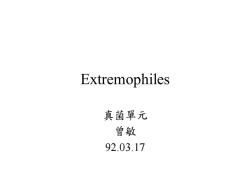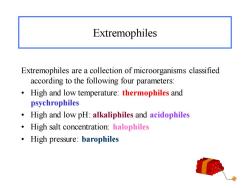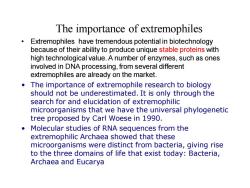《食品微生物学》课程教学资源(讲义)极端微生物(讲稿)真菌单元 Extremophiles

ktremophiles Life Under Extreme Conditions 極端微生物 微生物的多樣性表現在其生長環境,幾乎整個生物圈環境,都有微 生物存在。雖然大多數微生物只能在中溫和中性環境中生長,但有 些微生物卻能在特殊的環境中生存,例如高溫、低溫、高鹽、高鹼 、高酸、高壓、高輻射等環境。這些微生物由於適應特殊環境的結 果,形成獨特的機能、結構和遺傳基因,這類微生物稱為極端微生 物(extreme microorganisms,extremophiles),因為具有特殊的基因類 型、生理機制及代謝產物,是一群新型且具有很大開發潛力的生物 資源
極端微生物 微生物的多樣性表現在其生長環境,幾乎整個生物圈環境,都有微 生物存在。雖然大多數微生物只能在中溫和中性環境中生長,但有 些微生物卻能在特殊的環境中生存,例如高溫、低溫、高鹽、高鹼 、高酸、高壓、高輻射等環境。這些微生物由於適應特殊環境的結 果,形成獨特的機能、結構和遺傳基因,這類微生物稱為極端微生 物(extreme microorganisms, extremophiles),因為具有特殊的基因類 型、生理機制及代謝產物,是一群新型且具有很大開發潛力的生物 資源……

Extremophiles 真菌單元 曾敏 92.03.17
Extremophiles 真菌單元 曾敏 92.03.17

What are extremophiles? EXTREMOPHILES are organisms that require extreme environments for growth. Extremophiles are organisms that are "fond of"or "love"(- phile)environments including high temperature,pH, pressure and salt concentration,or low temperature,pH, nutrient concentration,or water availability. Extremophiles are also organisms that can tolerate extreme conditions including high levels of radiation or toxic compounds,or those living in conditions that we consider unusual Most extremophiles are microorganisms that thrive under conditions that from a human perspective are clearly extreme
What are extremophiles? • EXTREMOPHILES are organisms that require extreme environments for growth. • Extremophiles are organisms that are "fond of" or "love" (- phile) environments including high temperature, pH, pressure and salt concentration, or low temperature, pH, nutrient concentration, or water availability. • Extremophiles are also organisms that can tolerate extreme conditions including high levels of radiation or toxic compounds, or those living in conditions that we consider unusual. • Most extremophiles are microorganisms that thrive under conditions that from a human perspective are clearly extreme

Extremophiles A vast number of extremophiles belong to the Archaea.Some Archaea live near rift vents in the deep sea at temperatures well over 100.C. Others live in hot springs,or in extremely alkaline or acid waters.More recently, scientists have also found bacteria in these extreme environments.Indeed,the ratio of thermophilic bacteria to Archaea was 50 to 1 in a range of samples taken from Yellowstone Park's Obsidian Pool
Extremophiles • A vast number of extremophiles belong to the Archaea. Some Archaea live near rift vents in the deep sea at temperatures well over 100℃. Others live in hot springs, or in extremely alkaline or acid waters. More recently, scientists have also found bacteria in these extreme environments. Indeed, the ratio of thermophilic bacteria to Archaea was 50 to 1 in a range of samples taken from Yellowstone Park’s Obsidian Pool

Extremophiles Extremophiles are a collection of microorganisms classified according to the following four parameters: High and low temperature:thermophiles and psychrophiles High and low pH:alkaliphiles and acidophiles High salt concentration:halophiles High pressure:barophiles
Extremophiles Extremophiles are a collection of microorganisms classified according to the following four parameters: • High and low temperature: thermophiles and psychrophiles • High and low pH: alkaliphiles and acidophiles • High salt concentration: halophiles • High pressure: barophiles

Terms used to describe extremophiles include the following: .Alkaliphile:An organism with optimal growth at pH values above 10. .Barophile:An organism that lives optimally at high hydrostatic pressure. .Endolith:An organism that lives in rocks. .Extreme Acidophile:An organism with a pH optimum for growth at, or below,pH 3. .Extremophile:An organism that is isolated from an extreme environment and often requires the extreme condition for growth.Extreme is anthropocentrically derived. .Halophile:An organism requiring at least 0.2M salt for growth. .Hyperthermophile:An organism having a growth temperature optimum of 80 C or higher. .Psychrophile:An organism having a growth temperature optimum of 15 C or lower,and a maximum temperature of 20 C. .Toxitolerant:An organism able to withstand high levels of damaging agents.For example,living in water saturated with benzene,or in the wvater core ofa puclear reactor
Terms used to describe extremophiles include the following: •Alkaliphile: An organism with optimal growth at pH values above 10. •Barophile: An organism that lives optimally at high hydrostatic pressure. •Endolith: An organism that lives in rocks. •Extreme Acidophile: An organism with a pH optimum for growth at, or below, pH 3. •Extremophile: An organism that is isolated from an extreme environment and often requires the extreme condition for growth. Extreme is anthropocentrically derived. •Halophile: An organism requiring at least 0.2M salt for growth. •Hyperthermophile: An organism having a growth temperature optimum of 80 ℃ or higher. •Psychrophile: An organism having a growth temperature optimum of 15 ℃ or lower, and a maximum temperature of 20 ℃. •Toxitolerant: An organism able to withstand high levels of damaging agents. For example, living in water saturated with benzene, or in the water-core of a nuclear reactor

The importance of extremophiles 。 Extremophiles have tremendous potential in biotechnology because of their ability to produce unique stable proteins with high technological value.A number of enzymes,such as ones involved in DNA processing,from several different extremophiles are already on the market. The importance of extremophile research to biology should not be underestimated.It is only through the search for and elucidation of extremophilic microorganisms that we have the universal phylogenetic tree proposed by Carl Woese in 1990. Molecular studies of RNA sequences from the extremophilic Archaea showed that these microorganisms were distinct from bacteria,giving rise to the three domains of life that exist today:Bacteria, Archaea and Eucarya
The importance of extremophiles • Extremophiles have tremendous potential in biotechnology because of their ability to produce unique stable proteins with high technological value. A number of enzymes, such as ones involved in DNA processing, from several different extremophiles are already on the market. • The importance of extremophile research to biology should not be underestimated. It is only through the search for and elucidation of extremophilic microorganisms that we have the universal phylogenetic tree proposed by Carl Woese in 1990. • Molecular studies of RNA sequences from the extremophilic Archaea showed that these microorganisms were distinct from bacteria, giving rise to the three domains of life that exist today: Bacteria, Archaea and Eucarya

The research of extremophiles The first use of the term extremophile appeared in 1974 in a paper by MacElroy,R.D.(Biosystems 6: 74-75)entitled,"Some comments on the evolution of extremophiles.". First International Congress on Extremophiles was convened in Portugal,2-6 June,1996 The scientific journal,"Extremophiles",was established in February 1997. International Society of Extremophiles
The research of extremophiles • The first use of the term extremophile appeared in 1974 in a paper by MacElroy, R.D. (Biosystems 6: 74-75) entitled, "Some comments on the evolution of extremophiles.". • First International Congress on Extremophiles was convened in Portugal, 2-6 June, 1996 • The scientific journal, "Extremophiles", was established in February 1997. • International Society of Extremophiles

Application of extremophiles Biotechnological Application of Extremophiles The application of extremophilic microorganisms in industrial processes has opened a new era in biotechnology.Each group has unique features which can be exploited for use in biotechnological industries. The main reason for selecting enzymes from extremophiles are their high stability and reduced risk of contamination of the organisms which produce them.Additional benefits during production include improved transfer rates and lower viscosity
Application of extremophiles • Biotechnological Application of Extremophiles The application of extremophilic microorganisms in industrial processes has opened a new era in biotechnology. Each group has unique features which can be exploited for use in biotechnological industries. The main reason for selecting enzymes from extremophiles are their high stability and reduced risk of contamination of the organisms which produce them. Additional benefits during production include improved transfer rates and lower viscosity

Application of extremophiles ENZYMES AND EXTREMOZYMES:BEST SUITING INDUSTRY'S NEEDS .http://www.diversa.com/ Diversa Corp."a biotechnology company focused on globally accessing microbial diversity and using this untapped resource for discovering compounds which will benefit pharmaceutical,agricultural,and speciality chemical industries".By "untapped resource",Diversa refers to the enzymes contained in the estimated 99% of microorganisms that cannot be cultivated in the lab and thus have not yet been identified.Within those,the company specialises in "extremophiles,organisms living under extreme conditions,which have the highest economic potential
Application of extremophiles • ENZYMES AND EXTREMOZYMES: BEST SUITING INDUSTRY'S NEEDS • http://www.diversa.com/ • Diversa Corp. "a biotechnology company focused on globally accessing microbial diversity and using this untapped resource for discovering compounds which will benefit pharmaceutical, agricultural, and speciality chemical industries". By "untapped resource", Diversa refers to the enzymes contained in the estimated 99% of microorganisms that cannot be cultivated in the lab and thus have not yet been identified. Within those, the company specialises in "extremophiles," organisms living under extreme conditions, which have the highest economic potential
按次数下载不扣除下载券;
注册用户24小时内重复下载只扣除一次;
顺序:VIP每日次数-->可用次数-->下载券;
- 石河子大学:《食品微生物学》课程教学资源(大纲教案)食品微生物学教学大纲 Food Microbiology.doc
- 《食品微生物学》课程教学资源(书籍文献)食品微生物(原版教材)Modern Food Microbiology,Seventh Edition,2005(James M. Jay、Martin J. Loessner、David A. Golden).pdf
- 石河子大学:《食品微生物学》课程教学资源(大纲教案)食品微生物学课程教学大纲(理论含实验课,2014).doc
- 石河子大学:《食品微生物学》课程教学资源(大纲教案)食品微生物学实验教学大纲 Food Microbiology(2014).doc
- 石河子大学:《食品微生物学》课程教学资源(讲义)微生物课程学习笔记.doc
- 石河子大学:《食品微生物学》课程教学资源(大纲教案)食品微生物学考试大纲.doc
- 石河子大学:《食品微生物学》课程教学资源(实验讲义)食品微生物学实验指导书.doc
- 石河子大学:《食品微生物学》课程教学资源(讲义)食品微生物学讲稿(共十一章).doc
- 石河子大学:《食品微生物学》课程教学资源(大纲教案)食品微生物实验教学大纲 Food Microbiology.doc
- 石河子大学:《食品微生物学》课程教学资源(大纲教案)食品微生物学教案(任课老师:倪永清).doc
- 《植物生物学》课程教学资源(文献资料)剖析反对基因科技的心理动机.doc
- 《植物生物学》课程教学资源(文献资料)关于转基因食品.doc
- 《植物生物学》课程教学资源(文献资料)我国成首个批准主粮转基因种植国家.doc
- 《植物生物学》课程教学资源(文献资料)转基因主粮——不知能否醒来的民族噩梦.doc
- 《植物生物学》课程教学资源(文献资料)植物生物学名词解释2.pdf
- 《植物生物学》课程教学资源(文献资料)植物生物学名词解释1.pdf
- 运城学院:《植物生物学》课程教学资源(试卷习题)试题-10答案.docx
- 运城学院:《植物生物学》课程教学资源(试卷习题)试题-10试题.docx
- 运城学院:《植物生物学》课程教学资源(试卷习题)试题-9答案.doc
- 运城学院:《植物生物学》课程教学资源(试卷习题)试题-9试题.doc
- 《食品微生物学》课程教学资源(参考资料)微生物名词解释(Beta版).doc
- 《食品微生物学》课程教学资源(书籍教材)《食品微生物学实验技术》PDF电子版(共十四章,中国农业出版社:郝林).pdf
- 南京工业大学:《食品微生物学》课程教学资源(实验讲义)微生物学实验教学讲义(共十九个实验).pdf
- 河南牧业经济学院(郑州牧业工程高等专科学校):《食品微生物学》课程教学资源(实验讲义)微生物学实验指导(共十七个实验).pdf
- 《食品微生物学》课程教学资源(讲义)微生物学笔记.pdf
- 石河子大学:《食品微生物学》课程教学资源(讲义)霉菌的形态观察与鉴定(霉菌的无性孢子和有性孢子的形态观察).pdf
- 《食品微生物学》课程教学资源(参考资料)微生物的纯培养和显微技术.pdf
- 石河子大学:《食品微生物学》课程教学资源(试卷习题)微生物学实验复习题及其答案.doc
- 石河子大学:《食品微生物学》课程教学资源(试卷习题)微生物学补充练习题(无答案).doc
- 石河子大学:《食品微生物学》课程教学资源(试卷习题)2010食品微生物学试卷A(答案).doc
- 石河子大学:《食品微生物学》课程教学资源(试卷习题)2010食品微生物学试卷A(试卷).doc
- 石河子大学:《食品微生物学》课程教学资源(试卷习题)2008-2009食品微生物学A(无答案).doc
- 石河子大学:《食品微生物学》课程教学资源(试卷习题)2008-2009食品微生物学B(无答案).doc
- 石河子大学:《食品微生物学》课程教学资源(试卷习题)食品微生物检验考试大纲.doc
- 石河子大学:《食品微生物学》课程教学资源(试卷习题)食品微生物检验试卷A答案.doc
- 石河子大学:《食品微生物学》课程教学资源(试卷习题)食品微生物检验试卷A试卷.doc
- 石河子大学:《食品微生物学》课程教学资源(试卷习题)食品微生物检验试卷B答案.doc
- 石河子大学:《食品微生物学》课程教学资源(试卷习题)食品微生物检验试卷B试卷.doc
- 阿坝师范学院:资源与环境学院生物科学课程简介.pdf
- 阿坝师范学院:资源与环境学院生物科学学科专业基础必修课程.pdf
